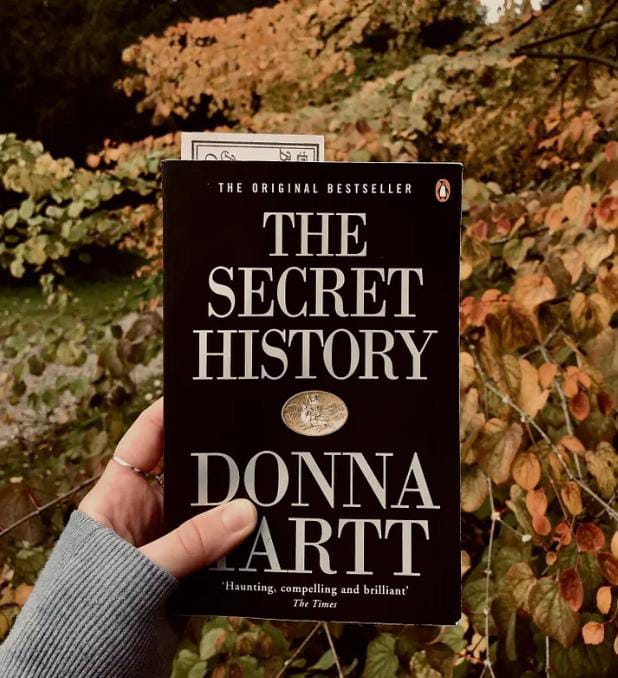BOOK REVIEW “THE SECRET HISTORY” by DONNA TARTT
Few books leave a reader in such a state of stupor and unease as The Secret History and I can say for certain that I haven’t read many books quite like it. It is the kind of book that, once finished, leaves you with an unsettling feeling, as if you’ve experienced something both extraordinary and illicit. The novel plunges you into a world so meticulously crafted that it almost feels unreal, a testament to Donna Tartt’s masterful storytelling.
What hooked me from the very beginning was how the book opens with a clear understanding of the plot and the events that will unfold. It’s like Tartt dropped a bomb on the reader right from the start. The opening line is unforgettable:
“The snow in the mountains was melting and Bunny had been dead for several weeks before we came to understand the gravity of our situation.”
For fans of dark academia, The Secret History is a quintessential read. The story is narrated by Richard Papen, a transfer student at Hampden College in Vermont, who becomes enthralled by a small, elite group of classics students. This group, consisting of Henry, Francis, the twins Camilla and Charles, and Bunny, exudes an air of sophistication and mystery that draws Richard in. Each member of the group is distinct in their characteristics—Henry, the intelligent and enigmatic leader; Francis, the sensitive and emotional one; the beautiful yet complex twins, Camilla and Charles; and Bunny, whose conflicting personality traits make him both endearing and infuriating.
Henry Winter, the leader, is portrayed as the most intelligent and commanding presence in the group. His peculiar nature keeps the others in line, and there’s an unspoken fear among them about his unpredictable intellect. Francis Abernathy, with his red hair and emotional sensitivity, is openly gay and harbours feelings for Charles, though they remain unspoken. The twins, Camilla and Charles Macaulay are depicted as extraordinarily beautiful, with a mysterious and tangled relationship that is slowly revealed as the story progresses. Bunny, or Edmund Corcoran, the one who introduces Richard to the group, is a contrast to the others—less wealthy, somewhat naive, but with a sharp tongue that often gets him into trouble.
An enigmatic figure in the novel is Professor Julian Morrow, who seems more concerned with aesthetics and appearances than with reality. His teachings encourage his students to embrace beauty to the point of losing control, and his influence on the group is profound, if not entirely positive. Richard notes about him: “One of Julian’s most attractive qualities is his inability to see anyone or anything in its true light, a quality that is both appealing and dangerous.”
As Richard becomes more entrenched in the group, he discovers that they have been performing Dionysian rituals, inspired by their obsession with Greek mythology. These rituals lead to the accidental killing of a farmer, an event that binds the group together in a dark secret. When Bunny learns of the murder, he becomes a liability, threatening to expose them. Henry, the mastermind, ultimately decides that Bunny must be silenced to protect their secret, leading to a chilling climax where the group murders Bunny by pushing him off a cliff.
The novel delves into themes of morality, or rather, the lack thereof. The group’s cold-blooded murder of Bunny and their subsequent attempts to justify it with intellectual reasoning blur the lines between right and wrong. Tartt explores the idea of how far individuals will go to preserve their sense of identity and belonging, even at the cost of their humanity.
A pivotal moment in the novel is when Richard Papen realizes he is irreparably tied to the group and their dark secret. This marks a turning point in his character, as he grapples with the weight of his actions and the consequences of his desire to belong. His initial admiration for the group’s intellectual pursuits turns to horror as he faces the reality of their crimes.
Tartt’s exceptional skill lies in her ability to create a narrative that feels both detailed and timeless. Her descriptions of the group’s eccentric mix of personalities at a small New England college are vivid and immersive. Even though the characters are deeply flawed—elitist, psychopathic, self-centred—they are portrayed in such a way that the reader cannot help but feel a strange empathy for them.
However, the novel is not without its flaws. The ending, while capturing the breakdown of the characters’ lives, feels somewhat rushed. Given the nearly 600-page length of the book, the detailed descriptions can at times feel overwhelming, yet they are essential in creating the atmosphere that makes The Secret History so compelling.
Despite its imperfections, The Secret History is a novel that lingers long after the last page is turned. Its exploration of beauty, morality, and the dark side of human nature makes it a book worth revisiting. For those with an eye for detail and a love for rich, complex narratives, this book is a must-read. Tartt’s debut novel remains a masterpiece that continues to resonate with readers decades after its publication.
Manal Mateen
manalmateen7@gmail.com




